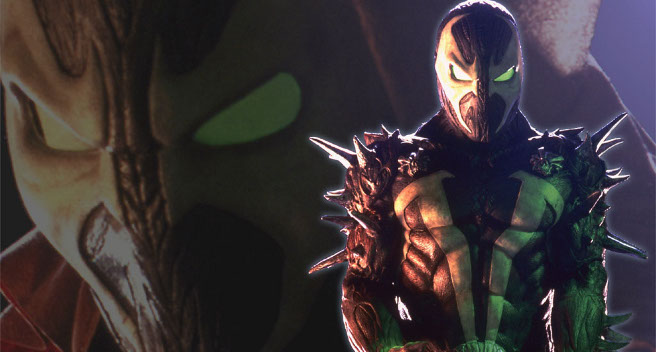
This is the thirty-fourth installment in a series of articles tracing the complete history of superheroes in film and television, from the first superhero serial all the way to the current Marvel and DC cinematic universes. For the previous installment click here, for the first installment click here.
In 1992, as one of the flagship characters of the fledgling creator-owned company Image Comics, Todd McFarlane created what would become one of the most popular superheroes of the 1990s – Spawn. Five years after the first issue hit newsstands, Spawn was being featured in his own feature film.
At the time, “Spawn” was easily one of the most anticipated films of the decade. Universal Pictures was originally in negotiation with McFarlane to produce a film based on the comic book as early as 1992, but those negotiations never came to fruition when Universal wouldn’t give McFarlane the creative control he wanted.
McFarlane eventually sold the film rights to Spawn to New Line Cinema for $1, provided he would be given complete creative control and all merchandising rights. New Line Cinema’s president, Michael DeLuca – who was a comic book collector himself – wanted to secure a property that already had the wide audience Spawn had. He did, however, have one stipulation to producing the film: he wanted the film to be rated PG-13, while retaining the darkness of the comics. DeLuca wanted the film to carry a PG-13 rating so that it could be marketed to a large audience. Achieving a PG-13 rating for “Spawn” would prove to be a Herculean task.
The film’s main production team was made up entirely of former Industrial Light and Magic employees. Mark A.Z. Dippé was hired as director, Clint Goldman came on as producer and Steven “Spaz” Williams became the visual effects supervisor and doubled as second unit director. Williams and Dippé were actually still attached to ILM when “Spawn” went into production and saw it as their way out of ILM.
“Spawn” was written by Alan McElroy, who had written issues of the Spawn comics and was head writer on the “Spawn” animated series the same year. McElroy also wrote the Christian films “Left Behind” and “Thr3e.”
“Spawn” received mostly negative reviews and currently holds a 19% on Rotten Tomatoes. The extremely formulaic nature of the film – adhering to every superhero movie trope and adding little to the genre – hurt the film. It also suffered from substandard special effects and CGI, even for the time. While many fans at the time felt the film was decent, it couldn’t maintain the longevity of a film like “The Crow,” which had a similar premise but was executed much better and didn’t adhere as much to the comic book superhero genre.
“Spawn” deviated in several places from the original comics, but most of these deviations were relatively minor. In the film, Spawn’s best friend Terry Fitzgerald – who is an African-American in the comics – was played by caucasian actor D.B. Sweeney in the film. Spawn’s original murderer was a character named Chapel, who was created by Rob Liefeld for his own “Youngblood” series. Since Chapel wasn’t a Spawn character, and since McFarlane didn’t own rights to that character, a new character named Priest was created to fill that role in the film. Also, in the comics Spawn was said to be infertile and unable to give his wife Wanda a child in life. After Spawn’s death, Wanda marries Terry and has his child. In the film, it is left rather ambiguous whether or not Cyan is Spawn or Terry’s daughter.
In spite of barely doubling its production budget, McFarlane immediately began promising a sequel that never materialized. After the turn of the century, sequel promises turned into dark reboot promises, more in keeping with the tone of the comics. Nothing came of any of these promises and Spawn’s cinematic future currently remains up in the air.
If you enjoyed this article, feel free to like me on Facebook, follow me on Twitter and check out my column at TheBlaze.
References:
“As Once-Dead Heroes Go, He’s Tough to Beat – latimes”. Articles.latimes.com. 2012-02-11
Marla Matzer (2010-03-08). “‘Spawn’ of a New Era : Studios Turning to Mix of Houses for Modest-Budget Effects Films “. L.A. Times
Wolf, Jeanne (1997-08-03). “Bringing The Dark Comic `Spawn’ To The Screen – philly-archives”. Articles.philly.com.
“The `Spaz’ Who Spawned His Own Style / Computer animator Steve Williams doesn’t look or think like a typical designer”. SFGate.
Beatty, Scott (August 1997). “Spawn: The Movie Figures”. Wizard (72): 86.
1 Pingback